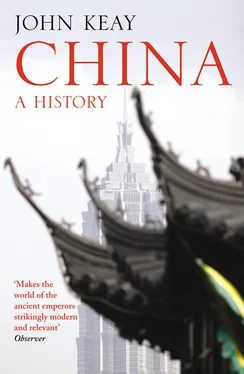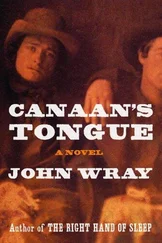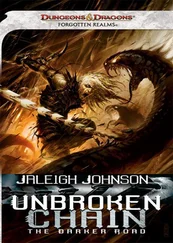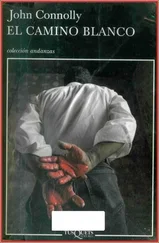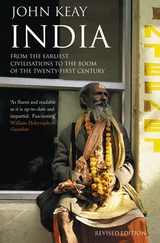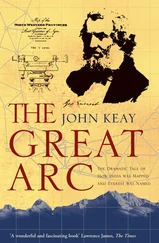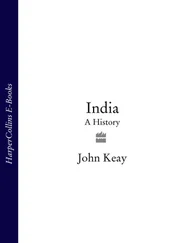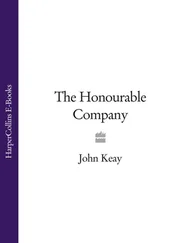Painstaking analysis of Zhou mortuary sites and buried hoards, both of them rich in bronzes, has led Rawson to another conclusion: that an extraordinary change, indeed ‘a revolution’, overtook Zhou ritual practice in the first years of the ninth century BC. Quite suddenly bronze vessels became larger and more standardised in form, and they often comprised sets of identical items; their designs betrayed an interest in recreating archaic forms; their inscriptions were much more formulaic than previously; and they were accompanied by a new repertoire of bronze bells and jades.
It was a ritual ‘revolution’ to the extent that these changes implied a grander, noisier and more staged liturgy under firmer central control and involving greater public spectacle. Its standardisation throughout the northern ‘Central Plain’ must have owed something to better communications; cultivation was evidently being extended and neighbouring fiefs were beginning to abut. Moreover, the inscribed bronzes were apparently doubling as archival records, like the Shang’s oracle bones, and being collected, displayed and hoarded as prestigious family heirlooms. But since they recorded royal favours, those who cherished them, and who in some cases had actually had them cast, were not their royal donors but their recipients, some of comparatively humble origin. The Zhou, in other words, were broadening their base of support while enhancing their own precedence.
Far from being a spent force then, by the early 800s BC Zhou authority, at least in ritual matters, was being projected more effectively than Shang authority had ever been. Rawson takes this to mean that the Zhou kings not only saw themselves as the successors of a unitary Shang state but ‘believed…that the natural condition of China was such a single state’ and proclaimed this political model with tenacity, despite the tensions it generated, ‘within the more naturally fragmented Chinese region’. 12
None of which is exactly contradicted by the dynastic dirge found in the written texts. Ritual rigidity need not, after all, imply political authority. The Zhou could have re-emphasised their formal precedence to compensate for military misfortunes; and their subordinate vassals could have conformed in ritual matters to disguise their political defiance. Alert to that correlational technique found in ‘The Book of Songs’, one should not perhaps look for explicit convergence. But it has to be said that this archaeological evidence for an ascendant Zhou is inconsistent, if not downright incompatible, with the written narrative of a declining Zhou.
According to the written sources, in 957 BC the Zhou king Zhao launched an ill-advised attack on Chu, a large tribute-paying but perhaps non-feudatory neighbour on Zhou’s south-eastern border. The Zhou were roundly defeated, six armies being ‘lost’ while the king himself ‘died’ – possibly drowned, probably killed. Thirteen years later King Mu, his successor, did rather better against the ‘Quan Rong’, a people on Zhou’s north-west frontier, but was unable to prevent the permanent breakaway of Zhou’s easternmost vassals. ‘The royal house declined and poets composed satires,’ says Sima Qian, main author of the first-century BC history known as the Shiji . The next king had to be ‘restored by the many lords’, presumably because his throne had been usurped; and his successor must have encountered further trouble in the east, for he had occasion to boil alive the chief of Qi (in Shandong) in a cauldron.
About 860 BC – so at the height of Zhou’s ‘ritual revolution’ – ‘great Chu’ took the offensive, invading Zhou territory and reaching a place called E in southern Henan. ‘The [Zhou] royal house weakened…some of the many lords did not come to court but attacked each other.’ Chu reinvaded in 855 BC, ‘the many lords’ continuing troublesome. The 200th anniversary of the Zhou’s triumph at Muye found their young king in exile. A regency modelled on that once headed by the Duke of Zhou took over and not until fourteen years later did it stand down for the exile’s son, Xuan.
King Xuan reigned long (827–782 BC) and aggressively. Vassal territories were reclaimed, tribute and trade relations with Chu may have been re-established, and western incursions by a people called the Xianyun (probably the same as the Quan Rong) were repulsed. But Zhou joy was short-lived. Heavy-handed intervention in Lu, another Shandong state, proved counterproductive, and ‘from this time on, the many lords mostly rebelled against royal commands’, says the Shiji.
The accession of King You in 781 BC was greeted by a cacophony of heavenly disgust, with a major earthquake, landslides and both a solar and a lunar eclipse. ‘How vast the woe!’ declared one of the Songs of such an appalling conjunction.
The hundred rivers bubble and jump,
The mountains and mounds crumble and fall,
The high banks become valleys,
And the deep valleys become ridges,
Woeful are the men of today! 13
Implicit in all this was criticism of the king himself. As with the last of the Shang kings, any ruler facing imminent disaster had previously to have been hopelessly discredited as a favoured Son of Heaven. King You supposedly ignored all the omens, flouted tradition by manipulating the succession in order to gratify his favourite consort, and alienated his remaining vassals by repeatedly summoning them to the defence of the realm against imaginary invaders. Apparently Bao Si, the beguiling consort in question, particularly enjoyed this wheeze. But the vassals soon tired of it, and when in 771 BC the Xianyun did indeed attack, King You’s cry of ‘wolf’ went unheeded. Left to their own devices, the Zhou were routed, their capital destroyed and their king killed.
Zhou fugitives, having hastily buried many bronzes for safe-keeping (and for the subsequent delight of archaeologists), headed east to their alternative capital at Luoyang. There, with the support of some still-loyal feudatories, King Ping, You’s son, was restored and the ancestral temples reconstituted. The Zhou were not finished; over 400 years remained to them. But now creatures of their erstwhile vassals, they reigned without ruling. Once emperors in all but name, they clung henceforth to such influence as their ritual precedence afforded, like popes in all but patronage.
So ended the Western Zhou ( c . 1045–771 BC) and so began the Eastern Zhou (772–256 BC). But because the Zhou kings would now play only a referee’s role in the political mêlée, the latter is less often referred to as a dynastic period – ‘Eastern Zhou’ – than as a dynastic hiatus. This hiatus, a recurrent phenomenon in Chinese history which will merit attention, is divided into two parts: the ‘Spring and Autumn’ period and the ‘Warring States’ period. Both terms derive from the titles of relevant historical texts, with the ‘Spring and Autumn’ Annals ( Chunqiu ) covering the years 770–481 BC and the ‘Warring States’ Annals ( Zhanguoce ) the years 481–221 BC. Although the cut-off date between the two periods is debatable (475 or 453 BC are often preferred), basically the whole span witnessed intense competition between the multiplicity of one-time feudatories, now considered ‘states’, within and around the crumbling Zhou kingdom along the lower Yellow River.
During the three centuries of the ‘Spring and Autumn’ period there were more of these ‘states’, they were smaller, and the scale of conflict was contained at a not too disastrous level. Something like 148 semi-sovereign entities are mentioned in the Zuozhuan , a commentary on the ‘Spring and Autumn’ Annals; clearly, not only the Zhou but also their subordinates had been freely indulging in the fissiparous ‘feudal’ enfeoffment of relatives and dependants. But thanks to a process of gradual conquest and elimination, the active participants in the political tournament became fewer, larger and more formidable. The 148 dukedoms, city-states, combined townships and assorted enclaves shrank to thirty or so, and during the ‘Warring States’ period these would be further consolidated into seven, then three, major participants. As the contest neared its climax, the stakes grew higher and warfare more intense. ‘Spring’ contrived a canopy of constitutional respectability to hide Zhou’s shame; ‘Autumn’ shredded this political foliage; and in its wintry aftermath, ‘warring state’ would clash with ‘warring state’ in a fight to the death.
Читать дальше
